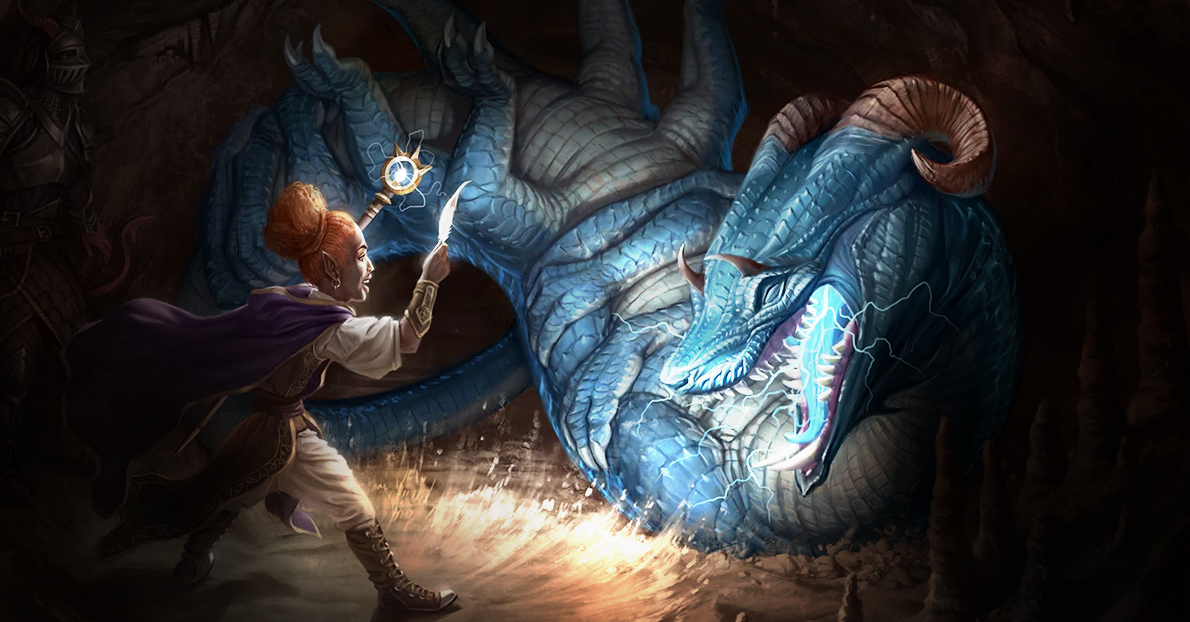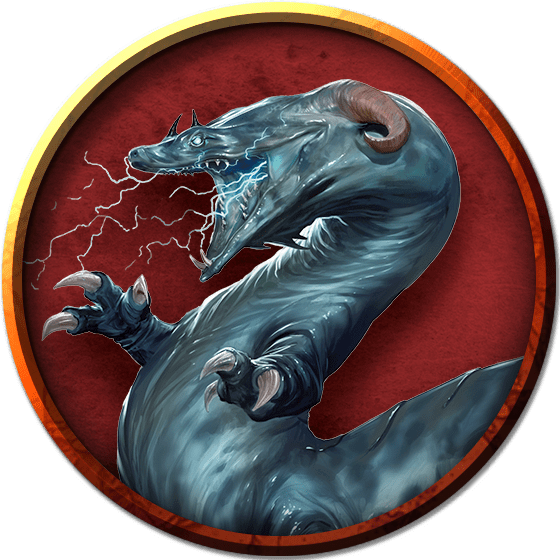Behir (/ˈbeɪ.hɪr/)
“I've already eaten three giant bats, six troglodytes, and a mind flayer today, but that's okay. Plenty of room in my belly for you and your friends.”
Basic Information
Anatomy
Description
A behir was often mistaken for a wingless blue dragon. It had a long, snake-like body and could slither on the ground like a snake, but it also had six pairs of legs upon which it could walk or climb if it chose to do so. Each of a behir's twelve feet contained three clawed toes. They began life with six or eight legs and grew additional legs as they aged. They grew about 8 feet (2.4 meters) per year. Behirs had thick, armored scales, much like a dragon. Their scales were colored in variations of dark blue, being lighter on their undersides. They had long narrow heads, crocodilian in shape, with curved, black horns on the top, which were used for preening. Behirs were born horn-less. Their mouths were full of many sharp multi-colored translucent teeth that were valued for their gem-like beauty, and their bones were crystalline. Newborn behirs were about 2 feet (0.61 meters) in length, while the typical adult behir was around 40 feet (12 meters) and weighed about 4,000 pounds (1,800 kilograms). Behirs reached adulthood at the age of ten and like other reptilian creatures would continue to grow throughout their lifetimes, having to shed their scales periodically. Because of this behirs could sometimes reach gargantuan sizes.Variations
Halruuan behir Halruaan behirs were a miniature species native to Halruaa, where they were bred as pets or guardians.Ecology and Habitats
Habitats
Behirs preferred to live in warm, hilly terrain. They made dens in caves—which were often in the side of high cliffs—or hidden thickets. A behir's territory usually encompassed an area of 400‑square-mile (1,000,000,000‑square-meter). Despite their nature, behirs were popular subjects of breeding in Halruaa. The varieties of brhir breeds was as diverse as the breeder's imagination allowed. They varied in size, color, and were used as guard dogs, or small hand-held pets. Behir hatcheries consisted of long shallow pools of water. They were fed with fish and eels. Those behir not sold alive were butchered and used for its material component and crafting materials.Dietary Needs and Habits
Diet
Behirs were a carnivorous species. Their main diet consisted of medium-sized animals, such as boars.Behaviour
Combat
If a behir grabbed a hold of an opponent or prey with its mouth, it had several options. It could wrap its body around the victim and constrict, it could tear at the victim with its many clawed limbs, or it could simply swallow the victim whole.Additional Information
Social Structure
Society
Behirs were usually solitary creatures, but could be found in mated pairs, though this only lasted until their eggs were hatched. They were most active during the day. And during the winter months they hibernated. Mating took place in early spring. Females produced between one and four blue-green, leathery eggs, which were buried under dirt or sand. There were conflicting reports about how long it took for their eggs to hatch. Some sources claimed it took eight months for them to hatch. Others insisted that it only took three or four weeks. The young were driven from the den soon after hatching.Uses, Products & Exploitation
Usages Behir horns could be used to make the ink necessary for scribing a magic scroll for a lightning bolt spell. Similarly, a scroll of neutralize poison often used ink from a behir's talons, and that of protection from poison used ink made from a behir's heart. Behir scales were sometimes used to make armor, much like the hides of dragons. Behir crystalline bones were used for scrimshaw. Bone-carved chimes, sculptures, and musical instruments were very common across Halruaan cities. Behir teeth were as beautiful and valuable as gemstones and had a wide variety of creative uses. One such use was a strange type of Haluaan music box that were invented at the Behir's Nest shop in Khaerbaal. Behir teeth formed plucking hooks that pulled on string made of behir guts and electrum, while behir ivory was used for other parts of these wondrous instruments.
Harvesting
Instructions| DC | Item | Description | Value | Weight | Exp | Crafting |
|---|---|---|---|---|---|---|
| 10 | Behir Scales (Large Bag) | Behir scaled are used by tailors and armorers, as they are lighter, smoother and more flexible than dragon scales. | 55 gp | 25 lb. | none | Scale Armor (DMG) |
| 15 | Behir Horn | As Behir's were created to fight dragons, their horn magically resonates when a dragon is nearby. Once a behir dies, the power is diminished significantly, but the horn is still effective. Use: The behir's horn will begin to vibrate when it comes within 1 mile of a dragon (whether in its true form or polymorphed), but does not point in any direction. The vibrations become more pronounced as it gets closer to the dragon. | 300 gp | 30 lb. | none | Dagger (DMG) |
| 20 | Lightning Sack | Harvested from the Behir's mouth, this light leathery sack contains caustic chemicals that continually crackle and pop. The sack is prized by alchemists, armorers and weaponsmiths. Use: The lightning sack can be thrown up to a range of 20 feet. If thrown, the sack explodes on impact, dealing 4d10 lightning damage to all creatures in a 10 foot radius, or half that on a successful DC 12 Dexterity saving throw. | 875 gp | 10 lb. | 7 days | Lightning Oil or Storm Caller (HHH) |
This kind of creature does not normally carry treasure. This kind of creature does not normally have or collect treasure. However, the creature may have a lair full of bodies, or reside somewhere that treasure already exists.
This creature produces 8-96 pieces of Harvested Meat, weight total of 4 lb each. DC: 5, Expire: 1 day, Value: 2 sp each. The meat of many monsters is considered vile and distasteful. Monstrosities and aberrations, in particular, may have tainted blood or rancid tasting meat. Dungeon Master's discretion.
Perception and Sensory Capabilities
Abilities
Behirs were known to be expert climbers. They were surprisingly quick, and could outrun the typical human. Behirs could breath a magical burst of electricity from their mouths, much like a blue dragon. (They themselves were completely immune to damage from electricity.) There were some reports that they were immune to poisons as well.Civilization and Culture
Major Language Groups and Dialects
History
Historical Figures
Notable Behirs
The lamia noble Transtra kept a behir as a companion, although she had to charm it to do so. Grimlight was a behir who lived in a gorge near the Cold Vale. Longjaws was a powerful behir who served the lich Alokkair. Vozhin was a behir who lived in the corpse of the primordial Petron, in the world of Abeir.Interspecies Relations and Assumptions
Relationships
Behirs sometimes served the dark Chultan demigod Eshowdow, and were seen as good omens by his followers. Behirs hated all dragons and would refuse to share any territory with them.Sources
Source(s):
- Mike Mearls, Jeremy Crawford, Christopher Perkins (2014-09-30). Monster Manual 5th edition. Edited by Scott Fitzgerald Gray. (Wizards of the Coast), p. 25. ISBN 978-0786965614.
- Rob Heinsoo, Stephen Schubert (May 19, 2009). Monster Manual 2 4th edition. (Wizards of the Coast), pp. 22–23. ISBN 0786995101.
- Skip Williams, Jonathan Tweet, Monte Cook (July 2003). Monster Manual v.3.5. (Wizards of the Coast), p. 25. ISBN 0-7869-2893-X.
- Doug Stewart (June 1993). Monstrous Manual. (TSR, Inc), p. 20. ISBN 1-5607-6619-0.
- Gary Gygax (August 1983). Monster Manual II 1st edition. (TSR, Inc), p. 18. ISBN 0-88038-031-4.
- Tony Jones (April 1990). “The Ecology of the Behir”. In Roger E. Moore ed. Dragon #156 (TSR, Inc.), pp. 101–105.
- Frank Mentzer (January 1985). “Ay pronunseeAYshun gyd”. In Kim Mohan ed. Dragon #93 (TSR, Inc.), p. 25.
- Elaine Cunningham (April 2000). The Magehound. (Wizards of the Coast), chap. 7, p. 95. ISBN 978-0-7869-1561-3.
- Elaine Cunningham (April 2000). The Magehound. (Wizards of the Coast), chap. 3, p. 44. ISBN 978-0-7869-1561-3.
- Elaine Cunningham (April 2000). The Magehound. (Wizards of the Coast), chap. 7, p. 94. ISBN 978-0-7869-1561-3.
- Thomas Reid (October 2004). Shining South. (Wizards of the Coast), p. 61. ISBN 0-7869-3492-1.
- Eric L. Boyd (September 1997). Powers & Pantheons. Edited by Julia Martin. (TSR, Inc.), p. 81. ISBN 978-0786906574.
- Christopher Perkins (November 2018). Waterdeep: Dungeon of the Mad Mage. Edited by Jeremy Crawford. (Wizards of the Coast), p. 158. ISBN 978-0-7869-6626-4.
- Steven E. Schend, Sean K. Reynolds and Eric L. Boyd (June 2000). Cloak & Dagger. (Wizards of the Coast), p. 148. ISBN 0-7869-1627-3.
- Ed Greenwood and Jason Carl (July 2002). Silver Marches. (Wizards of the Coast), p. 9. ISBN 0-7869-2835-2.
- Richard Baker, Eric L. Boyd, Thomas M. Reid (July 2007). Shadowdale: The Scouring of the Land. (Wizards of the Coast), p. 63. ISBN 07-8694-039-5.
- Erin M. Evans (2016). The Devil You Know. (Wizards of the Coast), p. 370. ISBN 978-0786965946.
- Steven E. Schend, Dale Donovan (September 1998). Empires of the Shining Sea. Edited by Julia Martin. (TSR, Inc.), p. 113. ISBN 0-7869-1237-5.
5E Statistics
 Basilisk
Basilisk
| Size | Huge |
| Type | Monstrosity |
| Alignment | Neutral Evil |
| Challenge Rating | 11 |
General Information
| Movement | Climbing |
| Vision | Darkvision, Low-light vision |
| Activity cycle | Day |
| Diet | Carnivore |
| Average lifespan | 50‒60 years |
| Language(s) | Common, Draconic |
| Subraces | Halruaan behir |
| Favored Climate | Any |
| Favored Terrain | Any |
Appearance
| Average length | 40 ft (12 m) |
| Average Weight | 4,000 lb (1,800 kg) |
| Skin color(s) | Deep blue to ultramarine with gray-brown bands |
| Distinctions | Serpentine body Twelve legs |
History
| First appearance | The Lost Caverns of Tsojcanth |
See Also: Behir on Forgotten Realms Wiki



